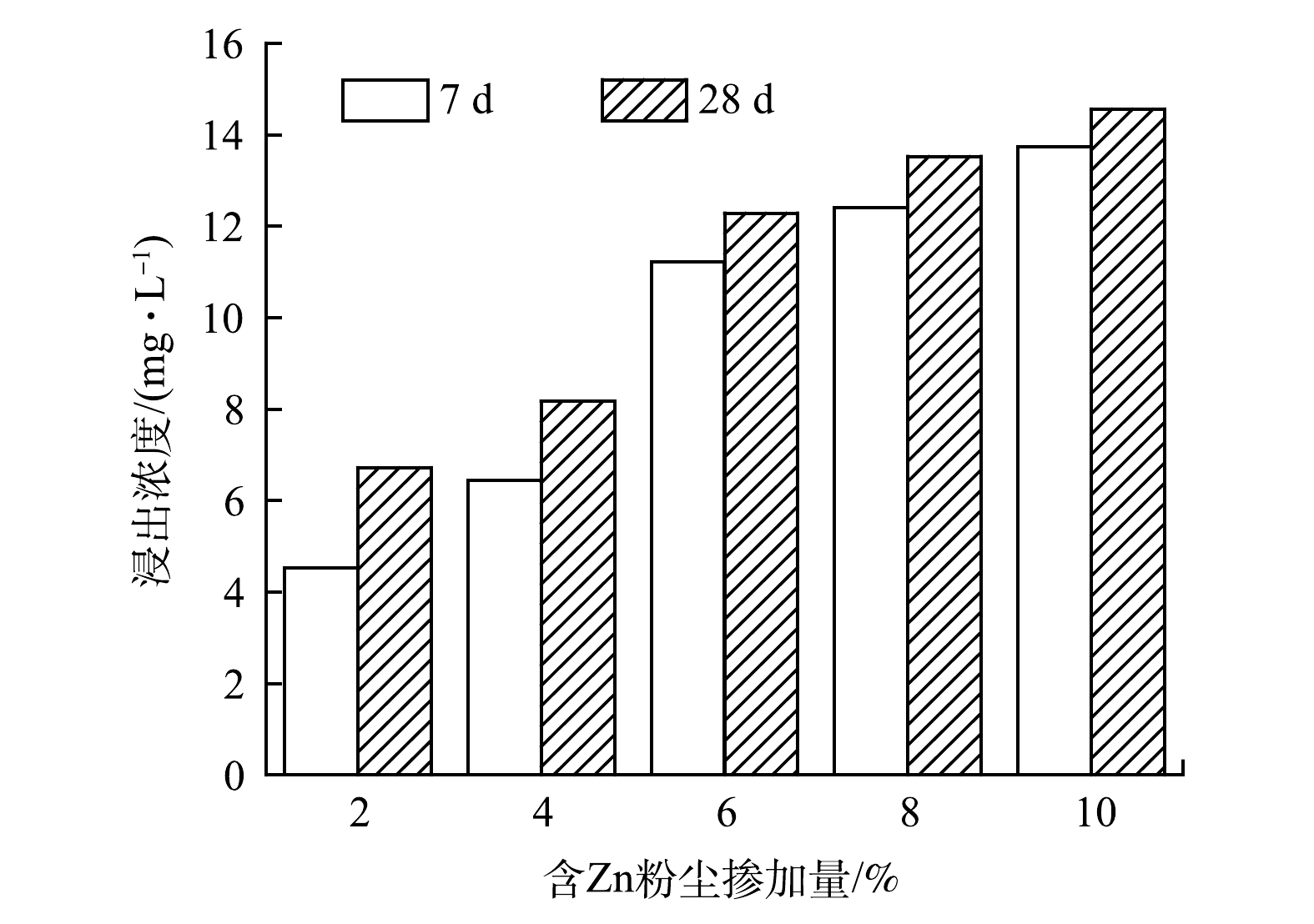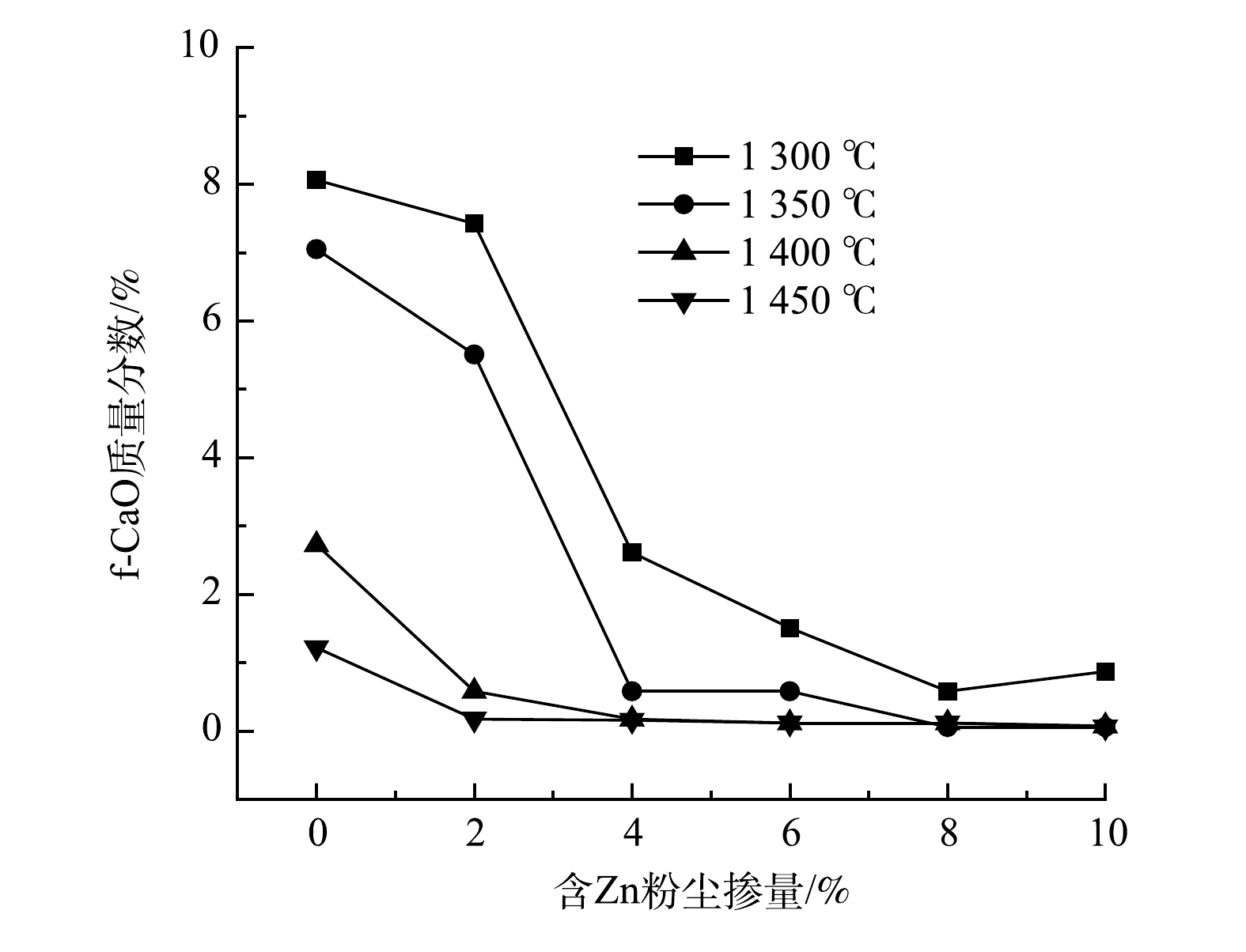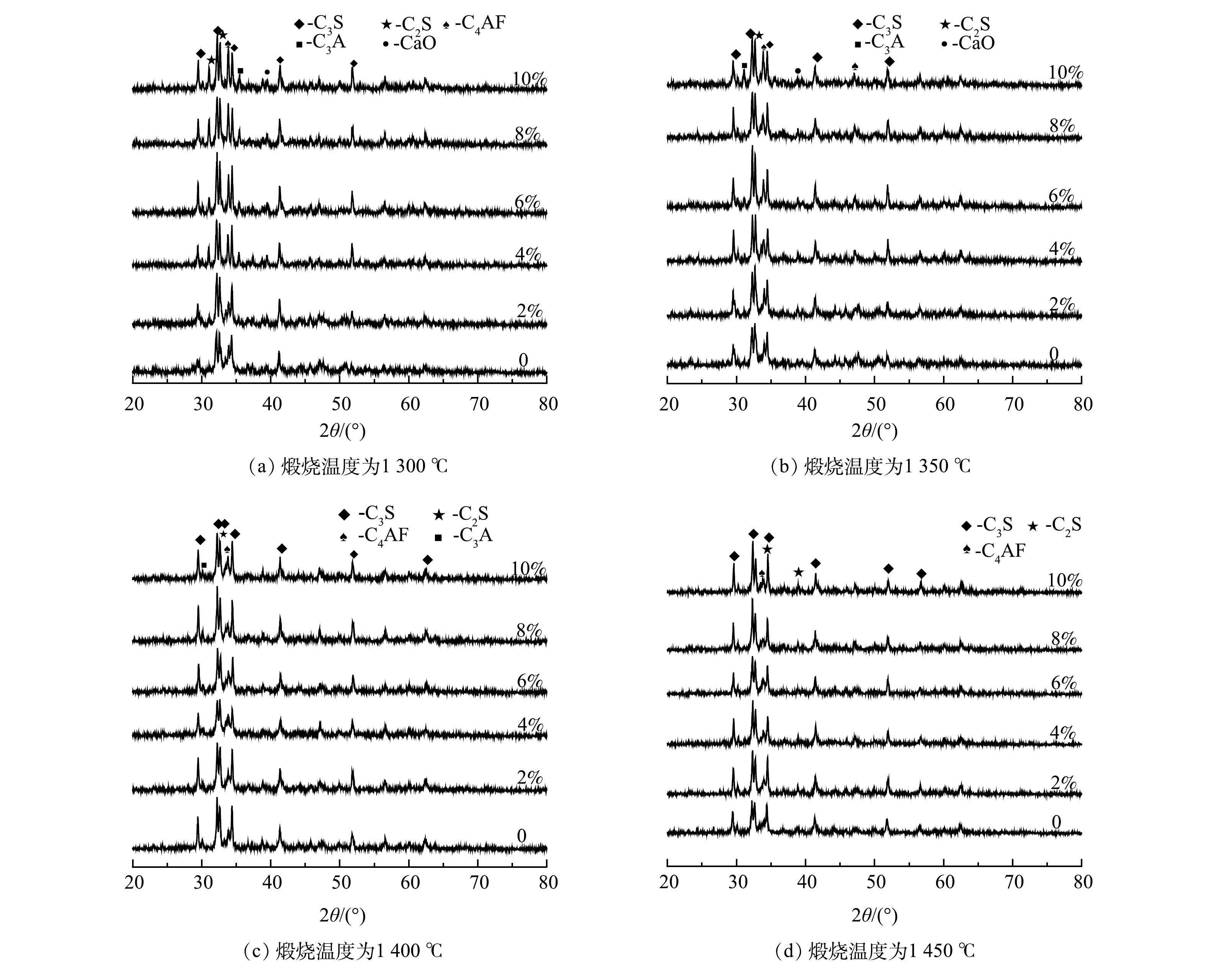-
随着工业化的快速发展,在社会生产中产生的废弃物总量也在逐年增加[1-3]。随着钢铁资源的需求快速增长,钢铁企业每年都会消耗大量资源,并排出大量的固体废弃物[4]。烧结、高炉、炼钢等生产过程产生的冶金粉尘,是钢铁企业主要废弃物之一[5]。由于粉尘中含有锌、铅、铬等重金属,1980年美国环保署(USEPA)将其划分为有毒固体废物[6];2016年我国将电炉粉尘和污泥列入《国家危险废物名录》[7]。含锌粉尘的简单堆积会造成资源浪费,而且其含有的重金属和有毒有害物质会随雨水渗入地下,造成地下水污染[8];若粉尘再次回配进入烧结工序中,将使炉内锌不断循环富集,导致锌负荷超标。同时,粉尘中的锌和碱金属元素对高炉而言属于有害元素,还会对企业的生产安全造成不良影响[9]。为响应发展循环经济和资源综合利用的要求,含锌粉尘的利用越来越受到相关企业和政府生态环境管理部门的重视[10]。
传统的粉尘处置方式分为湿法和火法工艺两种,湿法工艺是通过酸法或碱法制备浸出液,回收浸出液中的锌[11];火法工艺是利用锌沸点低且高温易挥发的性质,通过还原使粉尘中的锌再富集回收[12]。但含锌粉尘质量远比不上传统炼锌原料,故提锌价值有限且两种处理工艺都存在缺点。水泥窑协同处置技术因具有处置对象广、处置规模大、成本低、无次生危废等优势,被认为是一种高效处理固体废弃物的工艺方法[13]。回转窑内温度可高达1 600 ℃,物料在其中停留30 min,可以有效地焚烧固体废弃物[14-16]。由于我国对水泥、混凝土等基础型建筑材料需求巨大,水泥窑协同处置技术有很好的发展前景。目前,水泥窑协同处置含重金属的废弃物已经被广泛研究[17-19]。NAVARRO等[20]对普通硅酸盐水泥固化Zn和Cu进行了探索,发现Zn2+和Cu2+可被稳定的固化在水泥中。LIU等[21]发现,Cr、Cu、Zn主要以金属硅酸盐的形式加入熟料中。孙胜龙等[22]通过在水泥中单独掺加化学试剂和混合掺加化学试剂重金属元素,发现熟料试样在水化28 d时,各种重金属的浸出量低于工业固体废物浸出毒性鉴别标准规定的限值,不存在二次污染问题。
综上所述,水泥窑协同处置含重金属的废弃物是可行的。因此,本研究通过在生料中掺入不同量的含锌粉尘后烧制成熟料,通过f-CaO测定、X射线衍射(XRD)、分相萃取、电感耦合等离子体质谱(ICP-MS)和扫描电镜等测试手段,探究含锌粉尘的掺入对水泥熟料的煅烧温度、熟料中重金属的固化效果及其相分布,以及水泥净浆中重金属浸出浓度的影响,以期为水泥生产过程中更好地利用含锌粉尘提供参考。
-
实验用水泥生料和含锌粉尘均取自西安某水泥厂,含锌粉尘是该水泥厂处置的危险废物,来自当地某钢铁厂。水泥生料化学组成如表1所示,含锌粉尘的化学成分如表2所示。ZnO的含量最多,其次为Fe2O3和Na2O,同时还有少量的CaO和SiO2。
-
含锌粉尘在l00 ℃下干燥24 h,冷却后用球磨机磨细混匀后过200目筛备用。含锌粉尘在生料中的掺加量为2%、4%、6%、8%、10%。将水泥生料和含锌粉尘按比例配制好后,用行星式球磨机混合1 h。将混合物在5 kN下压成高度18 mm、直径40 mm的规则圆柱体状,将样品在室温下干燥1 d后放入高温炉中。从室温以10 ℃·min−1的速度加热至950 ℃,并保温0.5 h后,以5 ℃·min−1的速度分别加热到1 300、1 350、1 400和1 450 ℃,并保温3 h。将烧成后的样品利用风机使其快速冷却至室温,然后研磨至通过200目筛备用。
-
全消法用HCl-HNO3-HF溶液(HCl∶HNO3∶HF=3∶1∶1)对制备的熟料进行消解,用电感耦合等离子体质谱(OPTIMA 8000DV型,美国铂金埃尔默有限责任公司)检测滤液中重金属的浓度;根据《水泥化学分析方法》(GB/T 176-2017)[23]测定熟料中的游离氧化钙;将熟料研磨至20 µm,采用X射线衍射仪(D/MAX 2200型,日本理学Rikagu公司)检测熟料的矿物相,测试参数为Cu靶Kα线,管压40 kV,管流30 mA,扫描范围为20 °~80 °,连续扫描方式,扫描速率为1 °·min−1;用电子扫描显微镜(Quanta200型,美国FEI公司)分析1 450 ℃下烧制的熟料样品做背散射电子图谱和面分布图像,加速电压为20 kV,采用低真空模式,样品用环氧树脂封装并磨平。
分相萃取法。中间相的萃取:称取熟料2 g,湿磨至5 µm,加入萃取液(20 g水杨酸和200 mL甲醇,称为SAM溶液)中,30 ℃的水浴中磁力搅拌2 h后,静置、过滤、干燥,得到中间相。硅酸盐相的萃取:称取熟料3 g,湿磨至5 µm,加入萃取液(10 gKOH和10 g蔗糖溶解在100 mL去离子水中,称为KSOH溶液)中,在95 ℃的水浴中磁力搅拌5 min,迅速过滤,干燥,得到硅酸盐相。用全消法消解制好的中间相和硅酸盐相,滤液中重金属的浓度通过ICP-MS测定。
浸出实验。烧制好的水泥熟料中加入质量分数为5%的石膏磨制成水泥粉末。用制好的水泥做成净浆试块,养护7和28 d后,根据《固体废物浸出毒性浸出方法-水平振荡法》(HJ 557-2010)[24]进行重金属浸出实验,浸出液中重金属浓度用ICP-MS测定。
-
水泥熟料中重金属固化率的计算方法见式(1)和式(2)。水泥熟料中不同矿物相的重金属固化率的计算方法见式(3)。
式中:G为固定化率;Loss为烧失量,计算得为0.365;K表示熟料中的Zn离子质量分数,mg·kg−1;S为混合物(包括原料)的Zn离子质量分数,mg·kg−1;K与S值均为实际测量值。
式中:R为相对固化率;i是中间相和硅酸盐相;ai是矿物相i中的重金属质量分数,mg·kg−1;bi是熟料中矿物相i的质量分数,mg·kg−1;c是熟料中重金属质量分数,mg·kg−1。
-
水泥熟料中重金属固化率计算结果如表3所示。Zn离子在水泥熟料中的固化率在75%以上,最高可达到98%。随着含锌粉尘掺量的增加,Zn离子的固化率呈现先升高后降低的趋势,且在掺量为8%时达到最高。这说明,当粉尘掺量达到8%时,可能达到Zn离子在熟料中的存在阈值[25]。同时,Zn离子为低挥发性重金属,其理论固化率可达99%以上。但由于实际生产使用的回转窑密闭性好,且处于负压、强氧化环境,加之窑内粉尘浓度高,且与原料接触充分,故有利于重金属与熟料充分结合,Zn离子的实际固化率接近理论值;而实验室所用的高温炉在各方面的性能较回转窑要差,所以,在实验中所得到的固化率低于理论值,也低于工业窑炉的实际固化率[26]。
-
重金属浸出实验可以有效测定水泥制品中的重金属在环境中的浸出量,并对环境安全进行评估。图1为加入含锌粉尘的熟料制成的水泥净浆中Zn离子7和28 d的浸出浓度。Zn离子的最大浸出浓度为14.56 mg·L−1,而《危险废物鉴别标准 浸出毒性鉴别》(GB 5085.3-2007)[27]中对浸出液中Zn离子的限值为100 mg·L−1。同时,净浆中其他重金属元素浸出浓度亦极低,如Cr离子最大浸出浓度为1.28 mg·L−1,Pb离子最大浸出浓度为0.25 mg·L−1,均远低于国标规定的限值。随着粉尘掺量的增加,熟料中Zn离子质量分数随之增加,水泥净浆中Zn离子的浸出浓度也随之增加。但随着粉尘掺量的增加,净浆中Zn离子浸出浓度的增长趋势逐渐减缓;同时,水泥净浆中28 d时的Zn离子的浸出浓度均比7 d时的浸出浓度要高,但增长幅度不大。这说明,Zn离子可以很好地固化在水泥净浆中,且随着时间的增加,没有大量重金属逸出,不会对环境造成二次污染。
-
1)熟料中f-CaO分析。图2是含锌粉尘加入生料后烧制的水泥熟料中f-CaO的质量分数测定结果。随着煅烧温度的升高,熟料中f-CaO的质量分数均有大幅的降低,最低可降至0.06%。在1 300 ℃时,熟料的液相反应不完全,所以f-CaO的质量分数最高,空白样最高达到8.06%。随着粉尘掺量的增加,f-CaO质量分数大幅降低,在粉尘掺量为8%时,其f-CaO的质量分数仅为0.58%,已经低于1 450 ℃时空白样(1.21%)。在1 350 ℃时,粉尘掺量为4%的熟料中f-CaO的质量分数已降低至0.58%。在1 400 ℃时,粉尘掺量为2%的熟料f-CaO的质量分数降低至0.68%。这说明,含锌粉尘的加入可以有效降低熟料中f-CaO的质量分数,且在低温区(1 300 ℃)时,对熟料中f-CaO的质量分数降低效果最明显,f-CaO的质量分数从空白样的8.06%降低到0.58%。随着温度的升高,熟料烧成品质越好,其降低幅度变小,但整体仍处于降低状态。黄洋洋等[28]的研究结果表明,ZnO可以改善生料的易烧性,在较低温下明显促进f-CaO的吸收;不同煅烧温度下,随着ZnO掺量的增加,熟料中铝相减少,铁相增加,C3S矿物相增多。含锌粉尘的加入往生料中带入了大量的Zn离子,在熟料煅烧过程中可以降低熟料中矿物相的形成温度,并有效降低熟料中f-CaO的质量分数,从而显著改善熟料的易烧性。
2)不同温度下熟料煅烧样品的XRD结果。由图3可知,在1 300 ℃时,空白组的水泥熟料中C3S、C2S、C4AF、C3A矿物相的衍射峰都较弱且峰高较低。掺加含锌粉尘后,水泥熟料中各矿物相的衍射峰都有增强,其中,C3S、C2S和C4AF的衍射峰增强最为明显,并且随着粉尘掺量的增大,矿物相衍射峰的增强越明显。在1 350和1 400 ℃时,水泥熟料中的矿物相依旧是C3S、C2S、C4AF、C3A和少量的f-CaO。随着粉尘掺量的增加,C3S矿物相的衍射峰增强最为明显,C4AF矿物相的衍射峰也有所增强,含锌粉尘的加入会促进铁相的生成,降低液相黏度。且当1 400 ℃时,熟料中矿物相衍射峰的强度变化不大。这说明,该温度下熟料已经基本烧制成型。在1 450 ℃时,水泥熟料的主要矿物相为C3S和C2S,且随着粉尘掺量的增加,各衍射峰的强度变化不明显。这说明,水泥熟料各矿物相生长良好,熟料烧制完全成型,含锌粉尘的加入也没有新物质的生成,没有改变熟料的矿物相。结合熟料中f-CaO的质量分数变化规律,可认为含锌粉尘的加入,在水泥生料中引入了多种微量的金属元素,降低了熟料中的低共熔点,促使液相生成,也使熟料中主要矿物相C3S的形成温度降低,改善了熟料的易烧性。同时,因含锌粉尘的掺量较少,引入到熟料中的Zn离子的质量分数较低,且Zn离子以固溶体的形式存在于水泥熟料中,所以没有改变熟料原有的矿物相。
-
1)熟料分相萃取分析。采用分相萃取法研究了Zn元素在熟料中的固溶取向性。表4为中间相和硅酸盐相的质量分数。熟料的中间相中,Zn的质量分数约为21%,硅酸盐相中Zn的质量分数约为77%。
将提取的硅酸盐相和中间相酸消解后通过ICP-MS检测,表5为中间相和硅酸盐相中Zn离子质量分数及相对固化率。熟料中的Zn离子在中间相中固化率约为75%,硅酸盐相固化率约为25%。Zn离子在熟料中间相的固化率远大于其在硅酸盐相的固化率,这说明熟料的中间相对于Zn离子的固化能力强,Zn离子主要存在于中间相中。
图4为中间相和硅酸盐相的XRD谱图。中间相的衍射峰只有C4AF和C3A,加入含锌粉尘后C4AF峰值变高,硅酸盐相中C3S峰值在加入含锌粉尘后也有所增高。这同样说明,含锌粉尘的加入促进液相的生成,降低液相黏度,有利于C3S的形成。
2)熟料扫描电镜分析。为深入研究Zn元素在水泥熟料矿物中分布规律,对1 450 ℃烧制成的含锌粉尘掺量为10%的水泥熟料样品进行了背散射图像扫描,并对Ca、Si、Fe、Al、Zn等做元素分布的面扫描图像(见图5)。根据熟料的矿物形貌可以推断出,图中呈形状明显的多边形矿物为熟料中硅酸盐相。其中,多边形矿物周围的无定形状矿物为熟料的中间相,而由于元素的原子序数的不同,背散射图像中发亮部分为原子序数较大的重金属元素聚集区域,熟料中重金属元素主要集中分布在中间相中。由图5(f)可知,Zn在熟料中主要集中分布在熟料中Fe和Al富集的区域,同时,熟料中的Fe和Al主要存在于铁铝酸盐相中。这说明Zn主要存在于铁铝酸盐相中,与之前分相萃取计算结果一致。外来离子在晶体中发生固溶取代,占据的晶格位置与离子半径、电价、极性、配位数、电负性等化学结构参数有关。离子电价和电负性相近的元素易发生固溶取代,而Zn和 Fe都属于过渡性阳离子,他们的离子半径和电负性非常相近,Zn易与Fe发生固溶取代,从而存在于中间相中形成固溶体 [29-31]。
-
1)含锌粉尘中Zn离子在水泥熟料中的固化率随着含锌粉尘掺量的增加呈先增高后降低的趋势。当粉尘掺量为8%时,固化率最高可达98.11%。水泥净浆中Zn离子的浸出浓度随含锌粉尘的增加而增加。当含锌粉尘掺量超过6%后,浸出浓度增长速率逐渐变小;同时,最大浸出浓度为14.56 mg·L−1。这说明Zn离子可以有效固化在水泥净浆中。
2)含锌粉尘的加入在很大程度上降低了熟料中f-CaO的质量分数,显著改善了水泥熟料的易烧性。在低温煅烧时,对f-CaO质量分数降低最为明显;同时,含锌粉尘的加入可以降低熟料液相形成温度,从而降低熟料的煅烧温度。
3)熟料中Zn离子主要存在于中间相中。Zn离子在中间相中的相对固化率最低为73.04%,远高于硅酸盐相。Zn离子与Fe离子由于离子半径和电负性相近,易发生固溶取代形成固溶体存在于中间相中。
水泥窑协同处置含锌粉尘对水泥熟料性能及环境安全性的影响
Effect of cement kiln co-processing of Zinc-containing powders on clinker performance and leaching
-
摘要: 利用水泥窑协同处置技术对含锌粉尘进行了处置。通过掺入不同量的含锌粉尘煅烧成水泥熟料,探讨含锌粉尘中重金属离子对水泥熟料性能和环境安全性的影响。结果表明,含锌粉尘中的Zn离子可以被有效固化在水泥熟料中,固化率最高可达98.11%;Zn离子在水泥净浆中的浸出浓度低于工业固体废弃物浸出毒性鉴别标准的规定限值,故水泥熟料固化的危险废物在使用中不会对环境造成二次污染。此外,含锌粉尘的加入降低了f-Cao的质量分数,改善了水泥生料的易烧性;在熟料中,各矿物相对重金属元素的固化存在选择性,Zn离子在中间相中的固化率至少为73.04%,远高于其在硅酸盐相中的固化率;同时,背散射图像也表明,Zn离子主要存在于中间相。以上研究结果可为水泥窑协同处置含锌粉尘提供参考。Abstract: An experimental study to handle Zinc-containing powders by cement kiln technology was presented in the paper. Cement clinker was produced with raw meal after adding various amount of Zinc-containing powders; the effect of heavy metal ions confined in Zinc-containing powders on the properties of clinker, and its impact on environment, were then discussed. The results shoued that about 98.11% Zn ions in Zn-contained powders could be solidified into clinker minerals; the concentration of Zn ions leached in cement paste was lower than the requirements as specified in the Standard i.e., hazardous elements as solidified in cement clinker will not lead to secondary pollution to the environment. The addition of Zinc-containing powders reduced the mass fraction of f-Cao and improved the burnability of the cement raw meal. Heavy metal elements could be solidified in various degrees into different minerals. Zn ions solidification rate in the mesophase was greater than 73.04%, which was much higher than the rate in the silicate phase. This study can provide a reference for the co-processing of Zinc-containing powders in cement kilns.
-
Key words:
- zinc-containing powders /
- cement clinker /
- heavy metals /
- solidification /
- leaching
-

-
表 1 生料的化学组成
Table 1. Chemical compositions of cement raw material
% CaO SiO2 Fe2O3 Al2O3 MgO K2O P2O5 Na2O 42.75 13.96 2.35 3.33 0.97 0.89 0.75 0.66 表 2 含锌粉尘化学组成
Table 2. Contents of chemical components in Zinc-containing powders
% ZnO Fe2O3 Na2O CaO SiO2 F Cl MgO Al2O3 28.49 22.09 16.24 8.94 6.13 3.14 3.14 2.06 1.74 表 3 Zn离子在水泥熟料中的固化率
Table 3. Solidification rate of Zn ions in cement clinker
样品编号 含锌粉尘掺量/% Zn离子质量分数/(mg·kg−1) 固化率/% 混合物中 熟料中 Z1 2.0 5 155.45 6 247.58 76.95 Z2 4.0 6 178.89 7 783.14 79.99 Z3 6.0 12 463.09 17 841.35 90.90 Z4 8.0 16 116.91 24 901.39 98.11 Z5 10.0 19 770.73 25 130.50 80.71 表 4 中间相和硅酸盐相的质量分数
Table 4. Mass fraction of interstitial phase and silicate phase
样品编号 含锌粉尘掺量/% Zn的质量/g Zn的质量分数/% 熟料 中间相 硅酸盐相 中间相 硅酸盐相 R-I 0 2.009 0.416 - 20.71 - R-S 0 3.014 - 2.375 - 78.79 Z1-I 2.0 2.019 0.428 - 21.20 - Z2-I 4.0 2.014 0.434 - 21.55 - Z3-I 6.0 2.016 0.419 - 20.78 - Z4-I 8.0 2.018 0.439 - 21.75 - Z5-I 10.0 2.015 0.425 - 21.09 - Z1-S 2.0 3.016 - 2.334 - 77.39 Z2-S 4.0 3.014 - 2.337 - 77.54 Z3-S 6.0 3.017 - 2.361 - 78.26 Z4-S 8.0 3.020 - 2.339 77.46 Z5-S 10.0 3.019 - 2.342 - 77.58 注:样品编号中,R为空白组、Z为掺加含锌粉尘的样品组、I为中间相、S为硅酸盐相 表 5 中间相和硅酸盐相中Zn离子的固化率
Table 5. Content of Zn ions in different phases of clinker
样品
编号含锌粉尘
掺量/%Zn离子固化质量分数/ (mg·kg−1) 相对固化率/% 中间相 硅酸盐相 熟料 中间相 硅酸盐相 Z1 2.0 21 953.88 2 045.37 6 247.58 74.50 25.34 Z2 4.0 26 378.89 2 526.14 7 783.14 73.04 25.17 Z3 6.0 67 441.98 4 525.63 17 841.35 78.55 19.85 Z4 8.0 85 692.36 7 936.47 24 901.39 74.85 24.69 Z5 10.0 88 502.11 8 246.33 25 130.50 74.27 25.45 -
[1] CHENG J H, SHI F Y, YI J H, et al. Analysis of the factors that affect the production of municipal solid waste in China[J]. Journal of Cleaner Production, 2020, 259: 120808. doi: 10.1016/j.jclepro.2020.120808 [2] 王金星, 李长宽, 孙宇航. 固体废弃物处理研究[J]. 东北电力技术, 2019, 40(5): 49-51. doi: 10.3969/j.issn.1004-7913.2019.05.014 [3] WANG B M, FAN C C. Hydration behavior and immobilization mechanism of MgO–SiO2–H2O cementitious system blended with MSWI fly ash[J]. Chemosphere, 2020, 250: 126269. doi: 10.1016/j.chemosphere.2020.126269 [4] 马星宇, 彭军, 张芳, 等. 高炉粉尘有价元素提取的技术现状分析[J]. 中国铸造装备与技术, 2021, 56(1): 53-60. doi: 10.3969/j.issn.1006-9658.2021.01.008 [5] 殷磊明. 煅烧含锌粉尘回转窑结圈的研究[D]. 马鞍山: 安徽工业大学, 2017 [6] 杨冬伟, 郭键柄, 张琪, 等. 钢铁厂含锌粉尘的危害与处理技术[J]. 甘肃冶金, 2017, 39(4): 82-85. doi: 10.3969/j.issn.1672-4461.2017.04.022 [7] 生态环境部、国家发展和改革委员会、公安部、交通运输部、国家卫生健康委员会.国家危险废物名录(2021年版)[EB/OL]. [2020-11-27]. https://www.mee.gov.cn/xxgk2018/xxgk/xxgk02/202011/t20201127_810202.html, 2020 [8] 田玮, 彭犇, 王晟, 等. 含锌电炉粉尘处理技术的研究进展[J]. 环境工程, 2019, 37(2): 144-147. [9] 谭宇佳, 郭宇峰, 姜涛, 等. 含锌电炉粉尘处理工艺现状及发展[J]. 矿产综合利用, 2017(3): 44-50. doi: 10.3969/j.issn.1000-6532.2017.03.007 [10] 张伟, 赵德胜, 刘宝奎, 等. 工业化含锌粉尘处理技术现状及分析[J]. 鞍钢技术, 2018(2): 10-15. doi: 10.3969/j.issn.1006-4613.2018.02.003 [11] 谢泽强, 郭宇峰, 陈凤, 等. 钢铁厂含锌粉尘综合利用现状及展望[J]. 烧结球团, 2016, 41(5): 53-56+61. [12] 王天才. 回转窑处理钢铁含锌粉尘关键技术探析[J]. 中国资源综合利用, 2019, 37(7): 181-184. doi: 10.3969/j.issn.1008-9500.2019.07.059 [13] JIN R, ZHAN J Y, LIU G R, et al. Profiles of polychlorinated biphenyls (PCBs) in cement kilns co-processing solid waste[J]. Chemosphere, 2017, 174: 165-172. doi: 10.1016/j.chemosphere.2017.01.115 [14] 朱增银, 徐洁, 陈高, 等. 水泥窑协同处置固体废弃物的研究进展[J]. 环境科技, 2020, 33(2): 76-80. doi: 10.3969/j.issn.1674-4829.2020.02.016 [15] 范兴广, 杨玉飞, 刘锋, 等. 水泥窑共处置废物过程中重金属的流向分布[J]. 环境工程学报, 2014, 8(11): 4907-4912. [16] YANG Z Z, WANG C, WANG J F, et al. Investigation of formation mechanism of particulate matter in a laboratory-scale simulated cement kiln co-processing municipal sewage sludge[J]. Journal of Cleaner Production, 2019, 234: 822-831. doi: 10.1016/j.jclepro.2019.06.280 [17] KOSAJAN V, WEN Z, FEI F, et al. Comprehensive assessment of cement kiln co-processing under MSW sustainable management requirements[J]. Resources Conservation and Recycling, 2021, 174(2): 105816. [18] KOSAJAN V, WEN Z, ZHENG K F, et al. Municipal solid waste (MSW) co-processing in cement kiln to relieve China's MSW treatment capacity pressure[J]. Resources, Conservation & Recycling, 2021, 167: 105384 . [19] CLAVIER K A, WATTS B, LIU Y, et al. C, et al. Risk and performance assessment of cement made using municipal solid waste incinerator bottom ash as a cement kiln feed[J]. Resources, Conservation & Recycling, 2019, 146: 270-279. [20] NAVARRO A, CARDELLACH E, CORBELLA M. Immobilization of Cu, Pb and Zn in mine-contaminated soils using reactive materials[J]. Journal of Hazardous Materials, 2011, 186(2/3): 1576-1585. doi: 10.1016/j.jhazmat.2010.12.039 [21] LIU W, CAO H H, XU J C, et al. Effects of municipal sewage sludge on fixation of Cr, Ni, Cu, and Zn during co-processing of heavy metal-containing waste in cement kilns[J]. Journal of Wuhan University of Technology-Mater. Sci. Ed, 2018, 33(4): 892-900. doi: 10.1007/s11595-018-1910-0 [22] 孙胜龙, 白殿罡, 满文慧, 等. 水泥回转窑固化处理废弃重金属元素的实验研究[J]. 环境工程学报, 2007(8): 106-110. doi: 10.3969/j.issn.1673-9108.2007.08.023 [23] 中华人民共和国国家质量监督检验检疫总局, 中国国家标准化管理委员会. 水泥化学分析方法: GB/T 176-2017[S]. 北京: 中国标准出版社, 2017 [24] 环境保护部. 固体废物 浸出毒性浸出方法 水平振荡法: HJ 557-2010[S]. 北京: 中国环境科学出版社, 2010 [25] GINEYS N, AOUAD G, SORRENTINO F, et al. Incorporation of trace elements in Portland cement clinker: Thresholds limits for Cu, Ni, Sn or Zn[J]. Cement and Concrete Research, 2011, 41(11): 1177-1184. doi: 10.1016/j.cemconres.2011.07.006 [26] YANG Y F, XUE J C, HUANG Q F. Studies on the solidification mechanisms of Ni and Cd in cement clinker during cement kiln co-processing of hazardous wastes[J]. Construction and Building Materials, 2014, 57: 138-143. doi: 10.1016/j.conbuildmat.2013.12.081 [27] 国家环境保护总局, 国家质量监督检验检疫总局. 危险废物鉴别标准 浸出毒性鉴别: GB 5058.3-2007[S]. 北京: 中国环境科学出版社, 2007 [28] 黄洋洋, 齐砚勇, 邓磊. ZnO对硅酸盐水泥熟料矿物组成影响的研究[J]. 硅酸盐通报, 2017, 36(5): 1567-1572. [29] 崔素萍, 兰明章, 张江, 等. 废弃物中重金属元素在水泥熟料形成过程中的作用及其固化机理[J]. 硅酸盐学报, 2004(10): 1264-1270. doi: 10.3321/j.issn:0454-5648.2004.10.016 [30] 张文生, 任雪红, 欧阳世翕. 离子固溶对硅酸三钙结构及性能影响的研究进展[J]. 硅酸盐学报, 2011, 39(10): 1666-1672. [31] 魏丽颖, 刘姚君, 汪澜, 等. 重金属在水泥熟料矿物中的固溶机理研究进展[J]. 硅酸盐通报, 2014, 33(10): 2541-2546. -




 下载:
下载:





